Different gins explained
The many styles of gin

Gin is gin, and that's all there is to it, right? Not quite. Just like with other popular beverages like beer and wine, there are different styles of gin with various aromas and flavors that can be enjoyed in different ways. Here's a rundown of the most prominent gin styles and how you can get the most out of each style for a perfect gin experience every time.
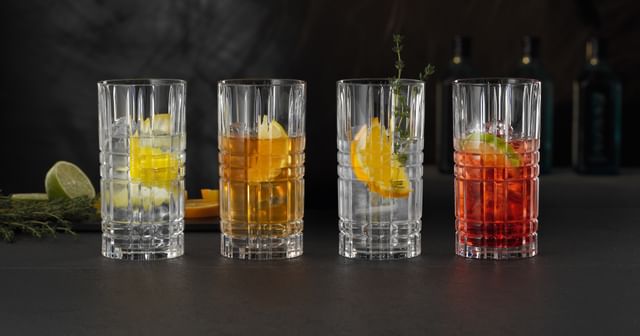
London Dry Gin
If you regularly enjoy a gin and tonic but don't take the time to check which gin it is you're using, chances are it's a London Dry style. London Dry Gin originated in London in the 19th century and has become the most popular gin style globally. Despite its name and London origin, London Dry Gin can be produced anywhere, with well-known London Dry distilleries existing all around the world. Several famous brands, including Tanqueray, Bombay Sapphire, Gordon's, and Beefeater Gin, exemplify London Dry Gin, illustrating its widespread popularity.
London Dry Gins are typically clean and crisp with distinct notes of juniper, which is added to the base spirit during distillation. Distillers can also add various herbs, citrus, spices, and roots to the gin during distillation, which is what makes different London Dry Gin brands distinct from one another. This clean character is due to London Dry Gin being made with very few additives; only water and a maximum of 0.1 grams of sweetening agent can be added to London Dry Gin after distillation, with no additional colorings or flavorings being permitted.
How to drink London Dry Gin
London Dry Gin is a versatile gin style that can be enjoyed in numerous ways. It is a popular choice for building a gin and tonic with, while it is also often used as the base in cocktails such as a gin sour or a gin fizz. A quality London Dry Gin can also be sipped neat, either in a chilled coupe, martini, or Nick & Nora glass, or in an old fashioned tumbler with a single cube of ice.
Plymouth Gin
Just like how London Dry Gin originated in London, Plymouth Gin originated in Plymouth, UK, in the late 18th century. However, in contrast to London Dry Gin, Plymouth Gin has a PGI status, meaning that only made in Plymouth can be classified as Plymouth Gin. Historically, there were several distilleries in Plymouth, but the only one still in operation today is the Black Friars Distillery.
While London Dry Gin is often very juniper-forward, Plymouth Gin uses a specific blend of seven different botanicals in its distillation process. Juniper berries, coriander seeds, orange peel, lemon peel, green cardamom, angelica root, and orris root are all added, giving Plymouth gin a full-bodied, balanced, fruity flavor.
How to drink Plymouth Gin
Like London Dry Gin, Plymouth Gin can be enjoyed in a variety of cocktails or a gin and tonic. Its more balanced flavor profile makes it an ideal gin option for those who might find London Dry Gins to be too harsh with their crisp, juniper-forward profile.
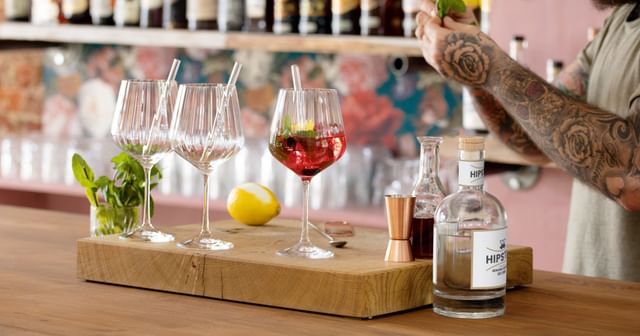
Old Tom Gin
Old Tom Gin is thought to be the oldest gin style that has remained into the modern day. Popular in the 18th century, Old Tom Gin was developed at a time when purification methods were not as advanced as today's standards, so spirits would often have sweeteners added to mask any unsavory flavors.
Old Tom Gin usually has a softer, subtly sweet profile compared to the likes of London Dry Gin. There are no strict rules for making an Old Tom Gin besides the extra sweetness, meaning they can vary considerably, with various sweetening agents, including honey and licorice, being used in its production. Old Tom Gins can also be barrel-aged, resulting in some of them having a darker color that is imparted by the wood.
How to drink Old Tom Gin
Old Tom Gin's sweeter flavor makes it ideal for use in spirit-forward cocktails, where its sweetness can work to take the edge off. A popular example of such use is the Martinez cocktail, which combines Old Tom Gin with sweet vermouth, maraschino liqueur, and bitters. If you prefer more voluminous cocktails, a traditional Tom Collins combines Old Tom Gin with syrup, lemon juice, and soda water for a beverage that provides a sweeter alternative to the gin and tonic.
Navy Strength Gin
As the name suggests, Navy Strength Gin is known for its high alcohol content. Originating in the 18th century, bottles of this gin style must come in at a minimum of 57% ABV. This defining feature is thought to have come from the fact that, at this strength or higher, if gin spilled onto the ship's gunpowder, the powder would still ignite.
Since Navy Strength Gin is defined by its alcohol content rather than any particular ingredients used during distillation, it can come in a variety of styles, particularly with the rise of the craft distillery movement in the 21st century. However, since all Navy Strength Gin is 57% ABV or higher, all gins of this style share the same quality of having an intense spicey, firey quality.
How to drink Navy Strength Gin
Due to its intensity, we recommend mixing Navy Strength Gin with ingredients that can balance out the overall drink. A classic gin and tonic works well for this gin style, as do gin-based cocktails that incorporate syrup, such as a gimlet.
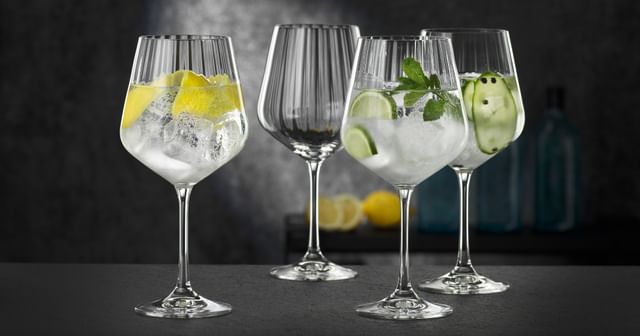
New Western Dry Gin
New Western Dry Gin emerged in the United States in the 21st century as part of the craft distillery movement. This method of gin production emphasizes the use of diverse botanicals during distillation, which adds depth, complexity, and fragrance to the gin. This means you can find bottles with a stronger floral emphasis, a stronger citrus emphasis, and everything in between. It also means that, typically, New Western Dry Gins have a much less juniper-forward profile than the likes of London Dry Gin.
How to drink New Western Dry Gin
As a modern variant of London Dry Gin, New Western Dry Gin is suitable for use in any classic gin-based drink, making it perfect if you're looking to add a subtle twist to your usual favorites.
Barrel-aged gin
Barrel-aged gin is another style of gin-making that has increased in popularity in the 21st century. As touched on earlier, some gins are aged in barrels after distillation to impart qualities from the barrel into the gin. As well as darkening the color of the gin, this aging imparts additional flavors into the gin, such as notes of oak, vanilla, and spice.
How to drink barrel-aged gin
The richness and complexity of barrel-aged gin make it ideal for use in classic cocktails. Try it in a gin-based old fashioned or in a negroni to allow the gin's character to shine through fully.
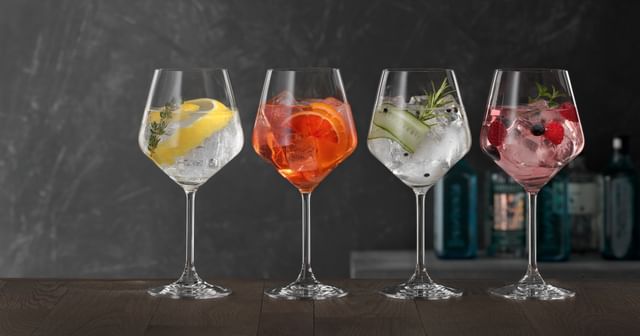
Sloe gin and other flavored gins
Flavored gins have grown in popularity since the late 20th century, but sloe gin - arguably the most famous type of flavored gin - has been around since the 17th century.
Flavored gins are usually technically classified as liqueurs due to often being 30-35% ABV and are made by adding extra ingredients to flavor the gin after distillation. Sloe gin does this using blackthorn berries (also known as sloe berries) and sugar, which, as with Old Tom Gins, would have originally been to cover up unpleasant smells that arose through inferior distilling practices of the time.
Today, sloe gin is known for being rich, smooth, and fruity and is made by some major gin producers, including Sipsmiths and Gordon's. Some other types of flavored gins that have been a prominent part of the rise in popularity of this gin style include berry-based gins, combinations like rhubarb and apple, and various citrus-flavored gins.
How to drink sloe gin and other flavored gins
Sloe gin is often enjoyed neat or over ice as a digestif, thanks to its rich, fruity flavor. You can also use sloe gin in place of other gin styles in most popular gin-based cocktails, including gin and tonics, negronis, and gin spritzs. Other flavored gins are commonly used in place of regular gin in a gin and tonic, so they might be worth trying if you're looking to mix up your usual G&T.
Genever/Jenever
The original gin style. Genever (spelled Jenever in the Netherlands) is a Dutch juniper-infused spirit that predates modern gin as we know it. It is made from malted grain, making it quite different from your usual gin, but its connection to modern gin means it simply has to be included in our list.
Genever has a more malt-forward flavor compared to other gin styles, as well as a heavier mouthfeel. It has been likened to a cross between gin and whisky, underlining the point that genever and gin are two quite different drinks.
How to drink genever
Genever is traditionally drunk neat from a small tulip-shaped glass without ice. It can also be used as a substitute for regular gin in a variety of classic cocktails and mixers, so feel free to have a play around if you have a bottle of genever that you're not sure what to do with.
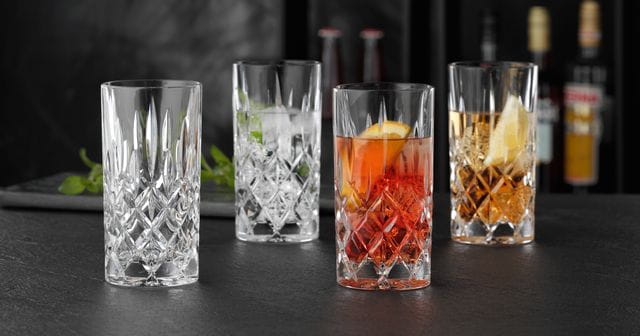
Glassware for your gin
Whichever gin style you prefer, at NACHTMANN, we deliver a range of expertly crafted crystal glassware that will get the best out of it.
- Our Gin and Tonic Glass allows your gin's botanicals to develop and shine for a perfect sipping experience.
- Lowball gin-based cocktails, such as the negroni or gimlet, or sloe gin served over ice, are best enjoyed from an old fashioned glass like one of the many crystal glass Tumblers – discover our Tumblers here.
- Highball glasses are best for gin cocktails that include a higher volume of mixer. For drinks like a gin fizz or a Tom Collins, we recommend one of our NACHTMANN Longdrink Glasses – discover Longdrink Glasses here, which are designed to maintain the effervescence of a sparkling beverage for as long as possible.
For more information on gin glassware and how the gin and tonic glass developed into the elegant gin balloons you see today, check out our blog detailing the Evolution of the Gin & Tonic Glass.
However you like to sip your gin, there is a style that perfectly suits your preferences. With so many gin styles to choose from, you have a wide range of flavors and aromas to try out so you can find the style you like best. If you’re interested in expanding your spirits know-how even further, consider exploring our rum blog and our article on different whisky styles.
Locations